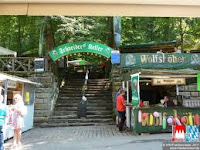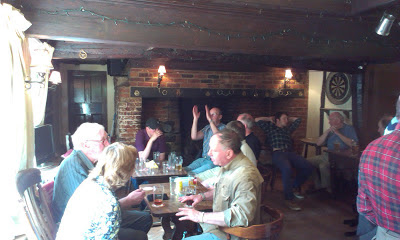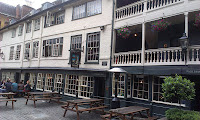I have written on at least two previous occasions about
the
CAMRA National Inventory listed
Old House, at Ightham Common. Sometimes
described as a “hobby pub” in so much it is only open during the evenings and
at weekends, as owner Nick Boulter has a full time job elsewhere, it should
more accurately, and more kindly, be described as a labour of love. It is
always a wonderful experience to visit this marvellously unspoilt pub, not
least because one is assured of being able to sample some excellent beer there.
So it was that last Saturday, a group of nine local CAMRA
members and friends boarded the 222 bus outside Tonbridge station, to make the
short journey up to
Ightham Common. En route we passed through some
unbelievably pretty places, including the large village
of
Plaxtol. This area was once
known for paper making, and this industry is celebrated in the name of one of
Plaxtol’s two pubs, the
Papermaker’s Arms. However, we were leaving the
delights of Plaxtol for another day, and another outing, and after our bus had
climbed the steep escarpment of the
Greensand Ridge, and deposited us just
outside Ightham village, we made the short walk down along Redwell
Lane, reaching the Old House just after 11.30.

Apart from regular customer and local CAMRA member Clive, we were
Nick’s first customers; in fact he had nipped outside for a crafty cigarette
before opening. He ushered us in and after we’d had the chance to peruse the
beers on offer, suggested to keep things simple we hold a “whip” whereby each
of us put a tenner into a kitty, and he would then take the drinks money from
that, as and when required. This seemed a good idea, so we all chipped in and
then proceeded to order our drinks. I started with
Dark Star Hophead, a bit of
a no-brainer really. It was pale, cool, refreshing and wonderfully hoppy, and I
was tempted to go for another had it not been for my attention being
caught by a beer from the
Bristol Beer Factory, called
Seven. Now beers from
this company are something of a rarity in rural Kent,
in fact I haven’t come across them outside of London,
so I made this my second pint of the day, and was glad that I did. Not
quite as overtly hoppy as the Dark Star, Seven was nonetheless an extremely
good pint. Several of my companions thought so as well.
Before going any further, a word or two as to the intended format of the day. The 222 bus service runs back and
forth between
Tonbridge and
Borough Green. It is operated by the same driver,
which means that it runs once every two hours in each direction, with a
three hour gap mid-afternoon to give the driver a break and the chance for some lunch. The idea was we would catch the 14.09 return service to
Tonbridge, but would break our journey at the small hamlet of
Dunks Green, home
to the
Kentish Rifleman, another excellent country pub which we don’t get to
visit all that often. We could then spend the next three hours there, catching
the 17.19 service back to Tonbridge or, mid afternoon, we could walk across country
to the somewhat up-market
Chaser Inn at Shipbourne, and then pick up the same
bus there a few minutes later.
Either option meant a problem with food; apart from nuts and
crisps, the Old House doesn’t do food, and we knew that the kitchen at the
Rifleman closed at 2.30pm. We didn’t
think the kitchen staff would fancy a rush, last minute scranble for food, so the
sensible option was to bring a packed lunch. Nick had no problem with us eating
our rolls inside the pub, but as it was such a nice day, several of us went and
sat outside, enjoying the sun which has been sadly missing for much of the
summer so far.

Alongside the Dark Star and the BBF beers, were
Wickwar
Coopers Ale, Mauldons Black Adder and
Young’s Ordinary. Dismissing the latter as no longer worthy of
consideration since its move to Bedford, I gave both the Wickwar and the Mauldons a try
before leaving, The pub had become quite crowded by the time of our departure;
not just with ourselves, but a healthy sprinkling of regulars, plus a group
from Croydon and Sutton CAMRA branch, It was also reported that a mini-bus load
of
SPBW (Society for the Preservation of Beer from the Wood) would be calling
in as well. (We spotted them in their bus, en route to the Old House, whilst
waiting for ours.) We departed shortly before 2pm,
thanking Nick for his hospitality and his great beer, and were waiting at the
stop in time for the onward bus to our next destination.
As I mentioned earlier, Dunk’s Green is nothing more than a
hamlet, but it is fortunate in still having its own pub, and a pretty fine one
too. Dating in part from the 16
th Century, the
Kentish Rifleman
survived a serious fire back in 2007, which necessitated some major restoration
work, especially to the roof. Looking at the pub today it’s difficult to imagine
just how bad the damage was at the time. The front entrance leads straight into
the main bar, which is long and low. Leading off from this is another long and
quite narrow room, which is slightly more upmarket, and is mainly used by
diners. At the rear of the pub is an attractive and secluded garden, and this
is to where most of us gravitated; all that is except Eric and I who stopped to
chat to a couple of characters sitting at the bar.
The Rifleman had four beers on offer – the low strength Tolly
Cobbold English Ale, Whitstable Native, Harvey’s
Best and Westerham 1965. The first two beers were on sale at £3.00 a pint,
whilst the latter two were more expensive, at £3.50. This price differential
reflects the wholesale prices charged by the respective breweries, as both
Harvey’s and Westerham are well-known in the trade for charging higher rates
for their beers. I sampled the Native and the 1965 and am pleased to report
both were in tip-top condition.

Eric and I joined the others in the garden for our second
pint; after all it was a shame to be stuck indoors on so pleasant a day. It was
from here that the majority of the group decided that a cross-country walk to
Shipbourne would be a good idea, as not only would it gives us some exercise,
but it would also give us a bit of break from the beer. It was the perfect
summer’s afternoon for a walk, most of which was across fields and through the
odd copse. Eventually we could see the tower
of Shipbourne church beckoning in
the distance across the grassy expanse of the common.
I can’t remember the last time I’d set foot in the
Chaser,
but I wouldn’t mind betting it was a quarter of a century ago. As I mentioned
earlier, it’s a somewhat up-market sort of place; nothing too stuck-up mind,
just rather expensive. The pub is part of a small chain called
Whiting &Hammond. The chain runs seven pubs in total, most of which are leased from
Greene
King. One of these is the
Little Brown Jug at
Chiddingstone Causeway,
which is five minutes walk away from where I work.
My company uses the Jug for entertaining
customers; leaving do’s and staff drinks each Christmas Eve, so I know the sort
of package the group offers. It is a good package, and the food is especially
recommended, with generous portions and some imaginative dishes, but of a
normal lunchtime I tend to steer clear, if only so as to keep a clear head for
the afternoon.
As well as Greene
King beers the Jug regularly stocks Larkin’s beer brewed just down the road, but
like most local pubs the Larkin’s on tap is the 3.4% Traditional Ale. Now for a
lunchtime pint this is a very good session beer that packs in lots of taste for
its low strength, but it’s not often one sees any of the other beers that the
brewery produces. I was especially pleasing therefore to walk into the Chaser
and see Larkin’s Best Bitter on sale. At a much more respectable 4.4% abv, the
Best is packed full of chewy-toffee, juicy-malt flavours which are perfectly
complemented by the WGV and Bramling Cross hops grown on the brewery’s own
farm. In fact, so good was the beer that
I didn’t mind paying the rather steep £3.80 a pint price tag.
We sat out in the garden at the side of the pub, which is
just in front of the church, enjoying the beer and making those who had
remained at the Rifleman jealous by posting text-messages telling them what
they were missing! We joined up with
them just before 5.30pm, despite
their having primed the bus driver not to stop for us! Back in Tonbridge, most of
the party, being gluttons for punishment decided to call in at the local
Wetherspoons. Myself and a colleague decided that discretion was the better
part of valour and that we’d had more than enough ale for one day. Not only
that but Spoons would have been somewhat of an anti-climax after three such
excellent pubs, so we stayed on the bus for a couple more stops before walking
back to our respective homes.
 Although pilgrims had been journeying to a nearby chapel
consecrated to St. Anna since the early 16th Century, Annafest in
its present form began in 1840, when the Forchheim shooting club moved its main
shooting ground from the "shooting meadow" on the river Regnitz to the Kellerwald. As well as plenty of beer drinking there are
other attractions such as fairground rides, various stalls, plus six stages
which feature a wide range of different musical acts. The local Forchheim
breweries Hebendanz, Greif, Eichhorn and Neder all brew a strong Bock beer especially for
this festival, the so-called Annafestbier, and a number of other local
breweries also supply brews of their own as well.
Although pilgrims had been journeying to a nearby chapel
consecrated to St. Anna since the early 16th Century, Annafest in
its present form began in 1840, when the Forchheim shooting club moved its main
shooting ground from the "shooting meadow" on the river Regnitz to the Kellerwald. As well as plenty of beer drinking there are
other attractions such as fairground rides, various stalls, plus six stages
which feature a wide range of different musical acts. The local Forchheim
breweries Hebendanz, Greif, Eichhorn and Neder all brew a strong Bock beer especially for
this festival, the so-called Annafestbier, and a number of other local
breweries also supply brews of their own as well. With seating for about 30.000 people,
the Kellerwald provides sufficient accommodation for the 450.000 - 500.000
visitors who come each year over the course of the 10-day festival period. A
regular shuttle bus service is provided from the town and surrounding areas to
the Kellerwald and back again, so getting to the festival is not a problem. For
those of a more energetic disposition, it is not that far to walk up from the
town and many people choose to do this, working up a king-sized thirst on the
way!
With seating for about 30.000 people,
the Kellerwald provides sufficient accommodation for the 450.000 - 500.000
visitors who come each year over the course of the 10-day festival period. A
regular shuttle bus service is provided from the town and surrounding areas to
the Kellerwald and back again, so getting to the festival is not a problem. For
those of a more energetic disposition, it is not that far to walk up from the
town and many people choose to do this, working up a king-sized thirst on the
way!







































